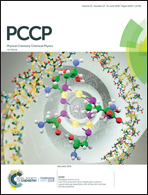Chemical kinetics of H-abstractions from dimethyl amine by H, CH3, OH, and HO2 radicals with multi-structural torsional anharmonicity†
Abstract
Dimethyl amine (DMA) is identified as a promising nitrogen-containing fuel candidate. To better understand the atmospheric and combustion chemistry of aliphatic amines, we systematically investigate the reaction kinetics of H-abstractions from DMA by H, CH3, OH, and HO2 radicals in a broad temperature range (100–2000 K). The BHandHLYP/cc-pVTZ method is adopted to determine the optimized geometries and frequencies, and the multi-structural torsional anharmonicity method (MS-T) is employed to characterize the effects of multi-conformer and torsional coupling for the involved species. High-level methods CCSD(T) and CCSD(T)-F12 combined with cc-pVXZ (X = D, T, Q), cc-pVXZ-F12 (X = D, T), and jun-cc-pV(T+d)Z basis sets are used to refine the electronic energies. The results of the gold standard method CCSD(T)/CBS(D–T–Q) with the zero point energy correction are adopted for the kinetic calculations. For the DMA + H/CH3 reactions, the conventional transition state theory (cTST) as well as one-dimensional Eckart tunneling correction is adopted. But for the DMA + OH/HO2 reactions, the reactant-complex (RC) is formed with a deep well (−6.4 and −11.7 kcal mol−1 for RC3 and RC4, respectively), due to the strong hydrogen bonding between the reactants. Hence, the variational transition state theory (VTST) combined with cTST is used to calculate the rate constants. The Rice–Ramsperger–Kassel–Marcus/master equation method is employed to determine the pressure-dependent rate constants in the pressure range of 0.001–100 atm. Our calculations are in agreement with previous experimental measurements and show well the trend in a broad temperature range. In addition, a pronounced pressure-dependence is observed under 400 K, indicating that pressure impacts the reaction mechanisms especially at atmospheric or interstellar temperatures.



 Please wait while we load your content...
Please wait while we load your content...